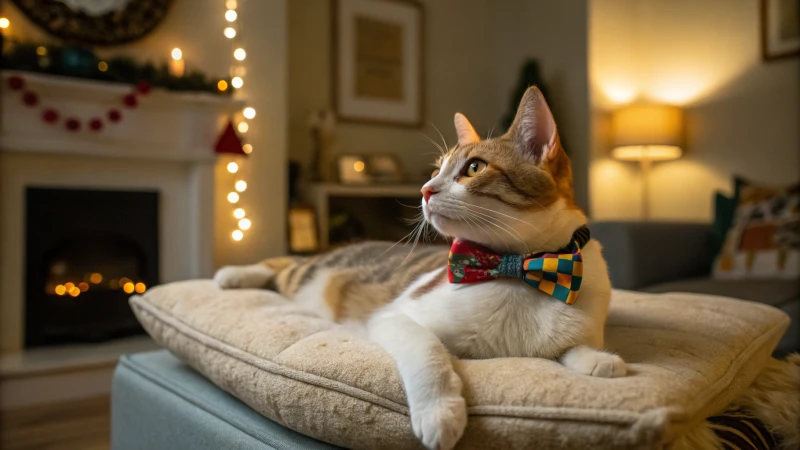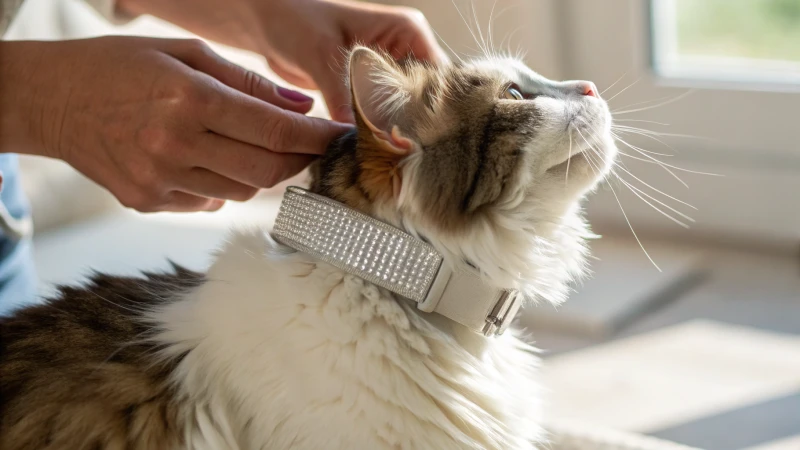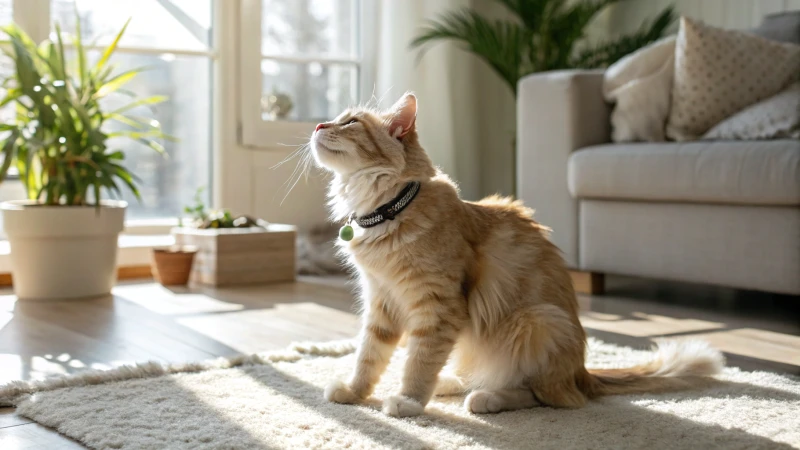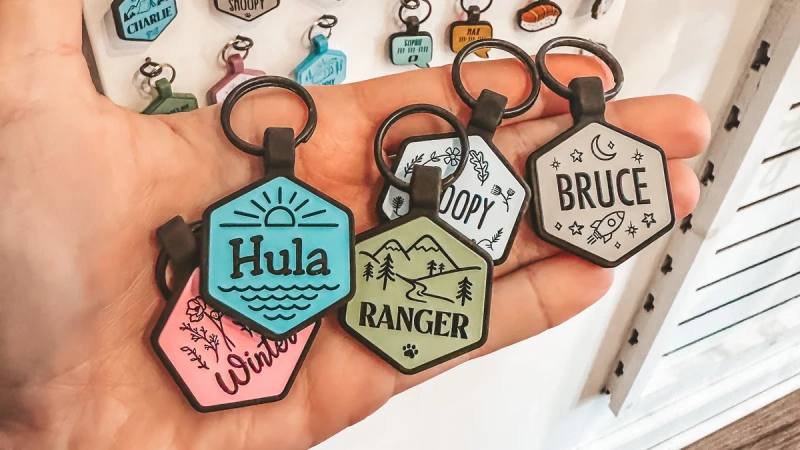
Ever tried adding a little flair to your cat’s wardrobe with a collar or bowtie? It’s not just about style—comfort and safety are crucial.
Cats can comfortably wear collars and bowties if they’re thoughtfully chosen, ensuring the right fit and type. Breakaway collars are safest, and gradually introducing them helps ease your cat into the new accessory. Keep an eye out for any signs of discomfort or irritation.
I remember the first time I slipped a bowtie on my cat, Mr. Whiskers. He gave me a look that said, "Seriously?" But after a few treats and some gentle coaxing, he strutted around like he was on a runway! The trick is understanding what works best for your feline friend.
Breakaway collars are a godsend—they pop off easily if your cat gets snagged, ensuring safety. I found that letting Mr. Whiskers sniff his new collar first and wearing it for short periods helped him adjust without fuss. It’s like introducing a new routine, like when I started yoga; you take it slow and easy.
Always keep an eye out for scratching or signs of irritation, as these could mean the collar isn’t quite right. Each cat is unique, and with a bit of patience, you can find the perfect accessory that lets them express their inner fashionista safely.
Cats can wear breakaway collars safely.True
Breakaway collars are designed to release under pressure, preventing injury.
All cats enjoy wearing bowties.False
Not all cats tolerate accessories; individual preferences vary widely.
What Are the Safest Types of Cat Collars?
Finding the perfect collar for your cat isn’t just about looks—it’s about ensuring their safety and comfort.
The safest cat collars are breakaway collars, which are designed to open under pressure to prevent choking or injury. These collars are a must-have for any cat owner who wants to ensure their pet’s safety while exploring.

Understanding Breakaway Collars
I remember the first time I heard about breakaway collars—it was after a close call with my adventurous tabby, Max. He got his old collar caught on a branch, and it could have been disastrous. That’s when I learned that breakaway collars are a lifesaver. They’re engineered to pop open if too much force is applied, keeping our feline friends safe from strangulation hazards. For active cats1 like Max, who seem to think they’re part-time explorers, this feature is absolutely essential.
Features to Look For
When I was picking out a new collar, I wanted something that Max would love and would keep him safe. Here’s what I looked for:
- Material: Opt for soft, hypoallergenic materials like nylon or leather. I’ve found that these materials are gentle on the skin and durable.
- Fit: It’s all about finding that perfect snug fit—enough to fit two fingers between the collar and your cat’s neck. It took me a few tries to get it right with Max, but once I did, it was like he wasn’t wearing anything at all.
- Safety Buckle: The breakaway buckle should be reliable—not too easy to open but will release when needed. After some trial and error, I discovered that not all buckles are created equal.
| Feature | Importance |
|---|---|
| Breakaway Buckle | Prevents choking in emergencies |
| Material | Reduces skin irritation |
| Fit | Ensures comfort without slipping off |
Alternatives to Consider
While breakaway collars are generally the safest choice, there are also GPS collars available. These can track your cat’s whereabouts but make sure they have a safety release mechanism. A friend of mine swears by them for her outdoor-loving kitty.
Introducing Your Cat to a Collar
When introducing Max to his new collar, I followed a gradual approach. At first, I let him sniff it out and then wear it for short stints while we played his favorite game of chase-the-string. Over time, he barely noticed it.
If your cat is anything like Max and seems uncomfortable at first, try experimenting with different materials or sizes until you find the right match. Keep an eye out for signs of distress2, like excessive scratching or attempts to remove the collar.
Considerations for Kittens and Indoor Cats
When I got a collar for my friend’s kitten, I opted for a smaller, lighter version. Kittens need something that doesn’t weigh them down. For indoor cats, even if identification isn’t as crucial, safety remains key if you decide on a collar.
Breakaway features are indispensable in these scenarios, providing peace of mind regardless of where your cat roams.
Monitoring and Maintenance
Regular check-ups on the collar are just part of the routine now. Every few weeks, I inspect Max’s collar for any signs of wear or tear—it’s surprising how much wear they can endure! Replacing it when necessary ensures his ongoing safety and comfort.
By keeping these tips in mind, you’ll be able to select a collar that offers both safety and style3 for your feline companion.
Breakaway collars prevent choking hazards for active cats.True
Breakaway collars snap open under pressure, preventing choking.
GPS collars are safer than breakaway collars for cats.False
GPS collars can be safe if they include a breakaway mechanism.
How can I properly fit a collar on my cat?
Ever tried putting a collar on your cat and wondered if it’s just right? I’ve been there.
To fit your cat’s collar correctly, it should be snug but comfortable, allowing you to slide one or two fingers between the collar and their neck. This ensures it won’t slip off easily while keeping your furry friend safe.

Understanding Different Types of Cat Collars
Choosing the right collar for your cat feels like a big decision, doesn’t it? I remember the first time I had to pick one out; I was overwhelmed by all the options. But once I learned a bit more about the types, it became easier. If your cat is anything like mine—curious and always getting into things—a breakaway collar might be your best bet. These collars are designed to release under pressure, which can prevent injuries if they get caught on something. It’s like having a little safety net for your adventurous feline.
| Collar Type | Safety Feature | Considerations |
|---|---|---|
| Breakaway | Releases under pressure | Ideal for adventurous cats |
Steps to Introduce a Collar
Start Slowly
Introducing a new collar can be a bit of an adventure for both you and your cat. When I introduced a collar to my kitty, I started by letting him sniff and explore it. This acclimatization process4 seemed to reduce his anxiety a lot.
Supervised Wear
Initially, I let him wear it for short periods while I kept an eye on him, gradually increasing the duration. Watching him get used to it was like watching a kid take their first steps.
Observe Behavior
It’s important to keep an eye out for any signs of discomfort. If your cat starts scratching at the collar or seems distressed, it’s time to reassess5 the fit or material.
Ensuring Proper Fit
A well-fitted collar should feel like a comfortable hug—not too tight, not too loose. Using the one to two finger rule has always worked for me: you should be able to slide one or two fingers between the collar and your cat’s neck.
- Snug Fit: Prevents slipping off without choking.
- Regular Checks: Cats grow; regularly check and adjust the fit.
| Fit Type | Description |
|---|---|
| Too Tight | Restricts breathing, causes discomfort |
| Too Loose | Risks slipping off |
| Just Right | Secure with room for two fingers |
Addressing Potential Concerns
Discomfort and Allergies
I’ve found that choosing soft, adjustable collars helps minimize any discomfort or allergies. Keep an eye out for redness or irritation around the neck area—your cat will thank you!
Noise from Bells
If noise bothers your cat, you might want to consider silent collars6. My cat didn’t like the bell, so switching to a silent collar made him much happier.
Breakaway collars are ideal for adventurous cats.True
Breakaway collars release under pressure, preventing injury if caught.
Flea collars can cause skin irritation in cats.True
Some flea collars may irritate; monitor your cat's skin for reactions.
Are There Any Risks with Cats Wearing Bowties?
When I first thought about putting a bowtie on my cat, I was worried about safety. Could something so cute be risky? Here’s what I found out.
Cats in bowties might face risks like choking, allergies, or discomfort. To minimize these, choose a bowtie with a breakaway feature and made from hypoallergenic materials.

Understanding the Potential Risks
I remember the first time I tried to dress up my cat, Whiskers, with a bowtie. It was adorable, but soon enough, I realized that it wasn’t all fun and games. Bowties can pose risks like choking hazards7 if they don’t have a breakaway design. Cats are naturally curious and might get their accessories snagged on furniture or even plants.
Allergic Reactions
The thought of Whiskers scratching incessantly due to an allergy broke my heart. Some materials used in bowties can cause allergic reactions, leading to redness or irritation. I learned to pick hypoallergenic fabrics, and now I’m always on the lookout for any signs of discomfort like skin irritation8.
Ensuring Comfort and Safety
Comfort is key when it comes to dressing our feline friends. I found that the two-finger rule—being able to fit two fingers between the bowtie and Whiskers’ neck—was a lifesaver. This way, I could ensure it wasn’t too tight or too loose.
| Aspect | Recommendation |
|---|---|
| Material | Hypoallergenic |
| Fit | Two-finger rule |
| Feature | Breakaway design |
Observing Your Cat’s Behavior
The first time Whiskers wore his bowtie, he acted like he was wearing an alien contraption! I had to monitor him closely. Watching for signs of discomfort such as pawing at the neck helped me know when to take it off. Introducing the bowtie gradually and letting him wear it for short periods really helped.
The Role of Design in Safety
Design matters just as much as material. Whiskers once tried to chew on a dangling part of his bowtie—lesson learned! Now, I opt for simple designs that focus on safety over fashion. Anything with small embellishments is a no-go, as these can be swallowed.
Collar safety9 is crucial. Bowties should meet similar standards to ensure they don’t compromise your pet’s well-being.
Cats can safely wear any bowtie design.False
Not all designs are safe; avoid those with small parts that can be swallowed.
Hypoallergenic materials prevent skin irritation in cats.True
Choosing hypoallergenic fabrics reduces the risk of allergic reactions and irritation.
How Can You Tell If Your Cat is Uncomfortable with a Collar?
Ever tried putting a collar on your cat and wondered if it’s causing them discomfort? Trust me, you’re not alone in this feline fashion dilemma!
To tell if your cat is uncomfortable with a collar, look for signs like constant scratching, trying to pull the collar off, or any change in their usual behavior. Make sure the collar fits well and isn’t causing irritation.

Signs of Discomfort
I remember when I first got a collar for my cat. She started scratching at it like it was some kind of tickle torture device! Cats are pretty expressive, and they’ll let you know if something’s off. Keep an eye out for excessive scratching, trying to Houdini out of the collar, or even mood swings like hiding under the bed or hissing at shadows. These are all red flags that something’s not right.
Proper Fit and Material
Getting the fit just right can feel like trying to solve a puzzle sometimes. It needs to be snug, but not so snug that it feels like you’re buttoning up your own shirt one size too small. The two-finger rule usually does the trick—just enough space to slip your fingers in comfortably. And trust me, soft, non-irritating material is a must; anything less and you’ll have a grumpy kitty on your hands.
| Feature | Ideal Condition |
|---|---|
| Collar Fit | Snug, two-finger rule |
| Material | Soft, non-irritating |
| Safety Mechanism | Breakaway feature |
Monitoring and Adjustment
The first time I let my cat wear her new collar, it was like watching her try on high heels for the first time—awkward and a bit wobbly. Start with short, supervised sessions and slowly increase the time as they get used to it. If they keep trying to wiggle free or scratch at it non-stop, maybe it’s time for a little adjustment—or even a collar swap.
- Excessive Scratching: This could mean the collar’s either too tight or made from something scratchy.
- Attempts to Remove: A clear sign they’re not happy; try adjusting the fit or switching to something lighter.
Behavioral Changes
Pay close attention to any behavior changes. If your usually playful furball suddenly prefers lounging over leaping, something might be bothering them. It’s worth checking if the collar type10 matches your cat’s unique personality and habits. Some cats are like silent ninjas; they get spooked by bells jingling every time they move.
Choosing the Right Collar
Safety first! Opt for collars with a breakaway feature to keep them safe if they get snagged. And if jingly noises aren’t their thing, there are plenty of silent options out there. Some cats might benefit from flea collars11 that do double duty, but be vigilant for any irritation or allergies.
Understanding these cues will help ensure your kitty stays comfy and happy in their stylish new accessory. After all, we want them strutting their stuff safely and fashionably!
Cats scratch collars due to tightness.True
Excessive scratching can indicate a collar is too tight or irritating.
All cats are comfortable with flea collars.False
Some cats may experience allergic reactions or skin irritation.
Conclusion
Cats can wear collars and bowties comfortably if they are well-fitted, made from safe materials, and introduced gradually. Breakaway collars ensure safety while allowing for personal style.
-
Discovering top-rated breakaway collars can help keep adventurous cats safe while exploring their environment. ↩
-
Learning these signs can help you identify if your cat is uncomfortable, ensuring their safety and comfort. ↩
-
Find fashionable collars that prioritize safety without compromising on style. ↩
-
Learn effective methods for introducing a collar to your cat, ensuring a smoother transition. ↩
-
Discover common indicators that a collar might be too tight, safeguarding your pet’s comfort. ↩
-
Explore why silent collars might be beneficial, especially for cats sensitive to noise. ↩
-
Learn why breakaway collars are essential in preventing choking hazards for cats. ↩
-
Discover which hypoallergenic materials can prevent skin irritation in cats. ↩
-
Find out more about ensuring safety with collars and pet accessories. ↩
-
Discover which collar types are best suited for cats, enhancing comfort and safety. ↩
-
Understand the pros and cons of using flea collars on cats. ↩



